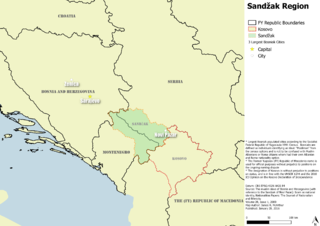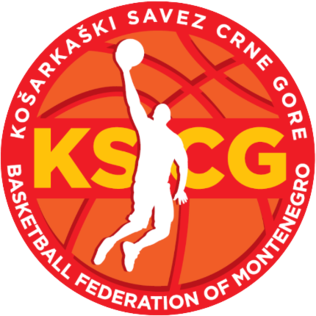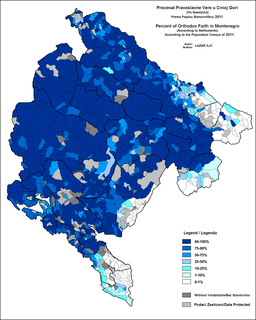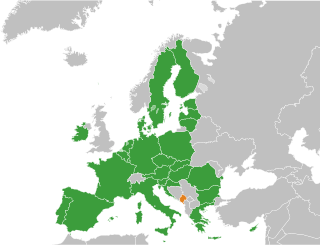
Montenegro is a country in southeast Europe on the Adriatic coast of the Balkans. It borders Bosnia and Herzegovina to the north, Serbia to the northeast, Kosovo to the east, Albania to the southeast, the Adriatic Sea and Croatia to the west. The largest and capital city Podgorica covers 10.4% of Montenegro's territory and is home to 29.9% of the country's population, while Cetinje has the status of old royal capital. Major group in the country are Montenegrins. Serbs form a significant minority at 28.7%, followed by Bosniaks, Albanians, Croats and Roma people.

The Federal Republic of Yugoslavia, commonly referred to as FR Yugoslavia or simply Yugoslavia, was a country in the Balkans, which came into existence in 1992, following the breakup of the SFR Yugoslavia. It comprised the Republic of Serbia and the Republic of Montenegro, the two remaining republics of Yugoslavia. In February 2003, FR Yugoslavia was transformed from a federal republic to a political union, and became officially known as the State Union of Serbia and Montenegro. In 2006, Montenegro seceded from the union, following an independence referendum which narrowly passed, leading to the full independence of Serbia and Montenegro.

Podgorica is the capital and largest city of Montenegro.

Sandžak or Sanjak, is a historical geo-political region in Serbia and Montenegro. The name Sandžak derives from the Sanjak of Novi Pazar, a former Ottoman administrative district founded in 1865. Serbs refer to the northern part of the region by its medieval name Raška.
Montenegrins are a South Slavic ethnic group native to Montenegro.
Montenegrin is a normative variety of the Serbo-Croatian language mainly used by Montenegrins and is the official language of Montenegro. Montenegrin is based on the most widespread dialect of Serbo-Croatian, Shtokavian, more specifically on Eastern Herzegovinian, which is also the basis of Standard Croatian, Serbian, and Bosnian.

Bijelo Polje is a town in northeastern Montenegro on the Lim River. It has an urban population of 15,400. It is the administrative, economic, cultural and educational centre of northern Montenegro.
Albanians in Montenegro are an ethnic group in Montenegro of Albanian descent, which constitute 4.91% of Montenegro's total population. They are the largest non-Slavic ethnic group in Montenegro.

The municipalities are the first level administrative subdivisions of Montenegro. The country is divided into 24 municipalities including the Old Royal Capital Cetinje and the Podgorica Capital City. Podgorica is divided into one subdivisions called city municipality, forming the basic level of local government.

Montenegro has participated in the Eurovision Song Contest 11 times. The country debuted in 2007. Previously it had participated as part of Yugoslavia and as part of Serbia and Montenegro.

Islam in Montenegro refers to adherents, communities and religious institutions of Islam in Montenegro. It is the second largest religion in the country, after Christianity. According to the 2011 census, Montenegro's 118,477 Muslims make up 20% of the total population. Montenegro's Muslims belong mostly to the Sunni branch. According to the estimate by the Pew Research Center, Muslims have a population of 130,000 (20.3%) as of 2020.

The Montenegro national football team has represented Montenegro in international football since 2007. It is controlled by the Football Association of Montenegro, the governing body for football in Montenegro. Montenegro's home ground is Podgorica City Stadium in Podgorica.

In a referendum on 21 May 2006, the people of Montenegro opted to leave the State Union of Serbia and Montenegro. This result was confirmed with a declaration of independence by the Montenegrin parliament on 3 June 2006. It simultaneously requested international recognition and outlined foreign policy goals.

Sergej Ćetković is a Montenegrin recording artist. He lives and works in the Serbian capital of Belgrade. Ćetković represented Montenegro in the Eurovision Song Contest 2014.

The Montenegro men's national basketball team represents Montenegro in international basketball tournaments. The supervising body is the Basketball Federation of Montenegro.

Eastern Orthodoxy in Montenegro refers to adherents, religious communities, institutions and organizations of Eastern Orthodox Christianity in Montenegro. It is the largest Christian denomination in the country. According to the latest census of 2011, 446,858 citizens of Montenegro (72.07%) registered as Eastern Orthodox Christians. The majority of Eastern Orthodox people in Montenegro are adherents of the Serbian Orthodox Church. A minor percentage supports the noncanonical and unrecognized Montenegrin Orthodox Church.

Accession of Montenegro to the European Union (EU) is on the current agenda for future enlargement of the EU.
Miss Montenegro is a national Beauty pageant in Montenegro.

Turks in Montenegro, also known as Turkish Montenegrins and Montenegrin Turks, are ethnic Turks who form an ethnic minority in Montenegro.

The Albanian revolt of 1911 or the Malësori uprising of 1911 was one of many Albanian revolts in the Ottoman Empire and lasted from 24 March 1911 until 4 August 1911 in the region of Malësia.















